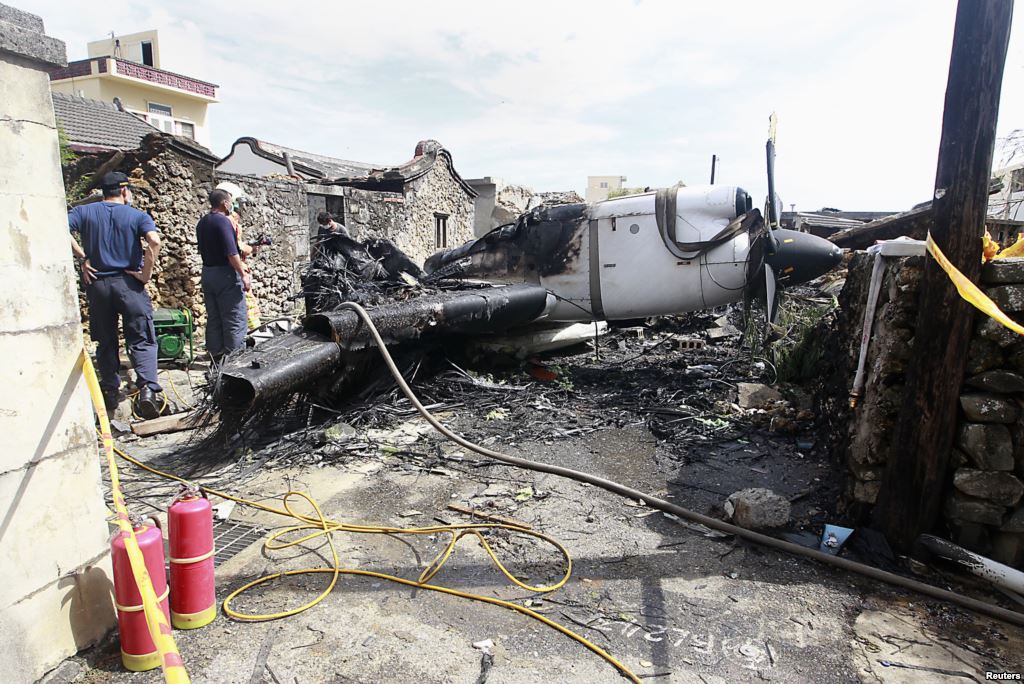Taiwan pilots couldn’t see runway 21 seconds before fatal crash

By Bloomberg
Pilots of a fatal July 23 TransAsia Airways Corp. flight couldn’t find the runway seconds before their aircraft crashed on Taiwan’s outlying Penghu islands, killing 48 people, according to an accident report published today.
“Have you seen the runway?” the captain of flight GE222 asked his first officer in Mandarin as their aircraft approached Magong Airport. “No,” the first officer responded clearly after nine seconds. The cockpit voice recording ended 12 seconds later, a transcript of the tape shows.
Ten people survived when the domestic flight from Taiwan’s southern Kaohsiung Airport hit houses in Penghu’s Xixi Village near the runway. The report is a factual account and doesn’t draw any conclusion or lay blame for the crash, Aviation Safety Council spokeswoman Sherry Liu said in an interview.
A draft assessment is expected to be completed in June with the final report to be published in October, the council said in a press statement today.
The two pilots of the ATR 72-500 twin-engine turbo- propeller aircraft knew that weather conditions fell below minimum requirements required to land at Magong when they took off from Kaohsiung at 5:45 p.m. on July 23, the council said. The same pilots had flown from Magong to Kaohsiung earlier in the day, it said.
The domestic flight usually takes 35 minutes, according to schedules posted on the Kaohsiung airport Website. Typhoon Matmo passed Taiwan earlier that day and had reached coastal China by early afternoon.
Thunderstorms
About 26 minutes after takeoff, flight GE222 was put in a holding pattern for 34 minutes during which time air traffic control reported wind conditions that would provide a headwind for aircraft landing at south-facing Runway 20, according to today’s statement. Aircraft usually takeoff and land into a headwind because it provides more lift at slower speeds.
At 6:21 p.m., while GE222 was flying circles in the skies between Penghu and mainland Taiwan, aircraft were advised that thunderstorms around Magong would likely continue for another hour. The thunderstorm warning was repeated 20 minutes later.
While wind conditions pointed to Runway 20, the pilots twice requested permission to land at the opposing north-facing Runway 02, which would give them a tailwind. Runway 02 has an advanced Instrument Landing System, or ILS, which assists pilots to fly the correct direction, altitude and glide slope. Their requests weren’t approved by Taiwan’s military, which also operates at the airport.
Runway 02
At 7:03 p.m., one hour and 48 minutes after takeoff and with the pilots established on their final approach path, GE222 was given permission to land at Runway 20 which has more basic navigation systems than Runway 02. That clearance was given six minutes after a similar aircraft operated by UNI Air landed successfully on the same Runway 20, the report shows. The UNI Air flight had also requested Runway 02 and didn’t get approval.
At 7:05 and 54 seconds, two minutes after getting landing clearance, GE222 passed below 200 feet and reached a critical moment called Missed Approach Point, at which pilots are required to discontinue the landing and execute a go around if they can’t see a prescribed visual reference, usually the runway.
Unseen Runway
Four seconds later Captain Lee Yi-lian, with almost 23,000 hours of flight time, asked his fateful question.
In the seconds it took for the aircraft to climb, bank sharply to the left and then point nose down, first officer Chiang Kuan-hsing replied in the negative.
“No,” Captain Lee echoed.
“No, sir,” his first officer repeated.
Four seconds later flight GE222, with 58 people on board, had descended to 72 feet, barely above the height of nearby trees.
“Go around,” they both called, boosting the engines’ throttle just seconds before the cockpit voice recorder captured an unidentified sound. Flight data shows an engine had slowed and the pitot tube, which sits on the outside of the plane and is used to measure airspeed, had been broken.
“Go around, go around,” the first officer radioed to the Magong control tower in English. “Roger,” came the reply.
Less than a second later, a final unidentified sound was heard before the voice recorder fell silent at 7:06 p.m.
Here we are to serve you with news right now. It does not cost much, but worth your attention.
Choose to support open, independent, quality journalism and subscribe on a monthly basis.
By subscribing to our online newspaper, you can have full digital access to all news, analysis, and much more.
You can also follow AzerNEWS on Twitter @AzerNewsAz or Facebook @AzerNewsNewspaper
Thank you!
